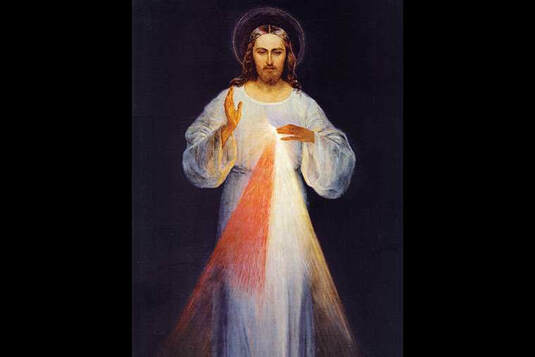Jesus, I trust in You
Original painting of the Divine Mercy, by Eugeniusz Kazimirowski in 1934
Per Wikipedia:
The Divine Mercy is a devotion to Jesus Christ associated with the apparitions of Jesus to Saint Faustina Kowalska. The venerated image under this Christological title refers to what Faustina's diary describes as "God's loving mercy" towards all people, especially for sinners.
Saint Faustina was granted the title "Secretary of Mercy" by Jesus himself and by the Holy See in the Jubilee Year of 2000. Sister Kowalska reported a number of apparitions during religious ecstasy which she wrote in her diary, later published as the book Diary: Divine Mercy in My Soul. The two main themes of the devotion are to trust in Christ's endless goodness, and to show mercy to others acting as a conduit for God's love towards them.
Pope John Paul II, a native of Poland, had great affinity towards this devotion and authorized it in the Liturgical Calendar of the church. The liturgical Feast of the Divine Mercy, is celebrated on the first Sunday after Easter. Worshipers of the Divine Mercy commemorate the Hour of Mercy (3 PM), the hour when Jesus died for us.
Another very popular form of the devotion is the Chaplet of the Divine Mercy. The Divine Mercy message highlights that God is a God of both mercy and justice. Jesus told Sister Faustina that those who run away from His merciful Heart will fall into the hands of His justice (entry 1728). With regard to Purgatory, He told her, "justice demands it" (entry 20). The devotion is believed to be the preparation for the end time.
The Divine Mercy is a devotion to Jesus Christ associated with the apparitions of Jesus to Saint Faustina Kowalska. The venerated image under this Christological title refers to what Faustina's diary describes as "God's loving mercy" towards all people, especially for sinners.
Saint Faustina was granted the title "Secretary of Mercy" by Jesus himself and by the Holy See in the Jubilee Year of 2000. Sister Kowalska reported a number of apparitions during religious ecstasy which she wrote in her diary, later published as the book Diary: Divine Mercy in My Soul. The two main themes of the devotion are to trust in Christ's endless goodness, and to show mercy to others acting as a conduit for God's love towards them.
Pope John Paul II, a native of Poland, had great affinity towards this devotion and authorized it in the Liturgical Calendar of the church. The liturgical Feast of the Divine Mercy, is celebrated on the first Sunday after Easter. Worshipers of the Divine Mercy commemorate the Hour of Mercy (3 PM), the hour when Jesus died for us.
Another very popular form of the devotion is the Chaplet of the Divine Mercy. The Divine Mercy message highlights that God is a God of both mercy and justice. Jesus told Sister Faustina that those who run away from His merciful Heart will fall into the hands of His justice (entry 1728). With regard to Purgatory, He told her, "justice demands it" (entry 20). The devotion is believed to be the preparation for the end time.
Divine Mercy Sunday Facts & Quotes
- St. Faustian was a Polish nun who lived in the early 20th century. She devoted her life to spreading the word about God's forgiveness, or divine mercy, for anyone who asks for forgiveness. Although she was a mystic, she also cooked and gardened as part of her convent life.
- St. Faustian had visions much of her life. One that was the most profound was of Jesus, with one hand raised in blessing and with two fingers of his other hand resting on his heart. She said that Jesus asked her to have the image painted, and to include a prayer that said, "Jesus, I trust in you." This is the prayer that Catholics recite on Divine Mercy Sunday.
- Most priests preach on the story of Doubting Thomas on Divine Mercy Sunday (John 20:19-31). Thomas, also a saint in the Roman Catholic Church, was one of the Jesus' apostles. When Jesus arose from the dead, he didn't believe it. Jesus directed him to touch his crucifixion wounds to help him believe. Jesus doesn't chastise Thomas for his disbelief, which is considered an act of mercy.
This feast teaches Catholics essential truths about God’s saving mercy,
|
Father Chris Alar of the Congregation of Marian Fathers of the Immaculate Conception of the Most Blessed Virgin Mary, has created a video series (click on buttons to the right to watch the videos) for Catholics to help us understand what the Divine Mercy devotion is and how we can live out its message in our own spiritual lives. You will gain a more complete understanding of God's mercy and the Divine Mercy devotion by hearing Fr. Chris explain ...
|
Divine Mercy home page:
https://www.thedivinemercy.org/
https://www.thedivinemercy.org/
_______________________________________________________
_______________________________________________________

